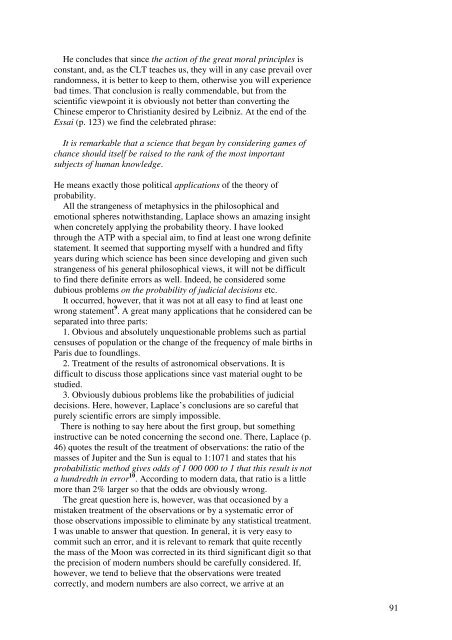1 Studies in the History of Statistics and Probability ... - Sheynin, Oscar
1 Studies in the History of Statistics and Probability ... - Sheynin, Oscar
1 Studies in the History of Statistics and Probability ... - Sheynin, Oscar
You also want an ePaper? Increase the reach of your titles
YUMPU automatically turns print PDFs into web optimized ePapers that Google loves.
He concludes that s<strong>in</strong>ce <strong>the</strong> action <strong>of</strong> <strong>the</strong> great moral pr<strong>in</strong>ciples isconstant, <strong>and</strong>, as <strong>the</strong> CLT teaches us, <strong>the</strong>y will <strong>in</strong> any case prevail overr<strong>and</strong>omness, it is better to keep to <strong>the</strong>m, o<strong>the</strong>rwise you will experiencebad times. That conclusion is really commendable, but from <strong>the</strong>scientific viewpo<strong>in</strong>t it is obviously not better than convert<strong>in</strong>g <strong>the</strong>Ch<strong>in</strong>ese emperor to Christianity desired by Leibniz. At <strong>the</strong> end <strong>of</strong> <strong>the</strong>Essai (p. 123) we f<strong>in</strong>d <strong>the</strong> celebrated phrase:It is remarkable that a science that began by consider<strong>in</strong>g games <strong>of</strong>chance should itself be raised to <strong>the</strong> rank <strong>of</strong> <strong>the</strong> most importantsubjects <strong>of</strong> human knowledge.He means exactly those political applications <strong>of</strong> <strong>the</strong> <strong>the</strong>ory <strong>of</strong>probability.All <strong>the</strong> strangeness <strong>of</strong> metaphysics <strong>in</strong> <strong>the</strong> philosophical <strong>and</strong>emotional spheres notwithst<strong>and</strong><strong>in</strong>g, Laplace shows an amaz<strong>in</strong>g <strong>in</strong>sightwhen concretely apply<strong>in</strong>g <strong>the</strong> probability <strong>the</strong>ory. I have lookedthrough <strong>the</strong> ATP with a special aim, to f<strong>in</strong>d at least one wrong def<strong>in</strong>itestatement. It seemed that support<strong>in</strong>g myself with a hundred <strong>and</strong> fiftyyears dur<strong>in</strong>g which science has been s<strong>in</strong>ce develop<strong>in</strong>g <strong>and</strong> given suchstrangeness <strong>of</strong> his general philosophical views, it will not be difficultto f<strong>in</strong>d <strong>the</strong>re def<strong>in</strong>ite errors as well. Indeed, he considered somedubious problems on <strong>the</strong> probability <strong>of</strong> judicial decisions etc.It occurred, however, that it was not at all easy to f<strong>in</strong>d at least onewrong statement 9 . A great many applications that he considered can beseparated <strong>in</strong>to three parts:1. Obvious <strong>and</strong> absolutely unquestionable problems such as partialcensuses <strong>of</strong> population or <strong>the</strong> change <strong>of</strong> <strong>the</strong> frequency <strong>of</strong> male births <strong>in</strong>Paris due to foundl<strong>in</strong>gs.2. Treatment <strong>of</strong> <strong>the</strong> results <strong>of</strong> astronomical observations. It isdifficult to discuss those applications s<strong>in</strong>ce vast material ought to bestudied.3. Obviously dubious problems like <strong>the</strong> probabilities <strong>of</strong> judicialdecisions. Here, however, Laplace’s conclusions are so careful thatpurely scientific errors are simply impossible.There is noth<strong>in</strong>g to say here about <strong>the</strong> first group, but someth<strong>in</strong>g<strong>in</strong>structive can be noted concern<strong>in</strong>g <strong>the</strong> second one. There, Laplace (p.46) quotes <strong>the</strong> result <strong>of</strong> <strong>the</strong> treatment <strong>of</strong> observations: <strong>the</strong> ratio <strong>of</strong> <strong>the</strong>masses <strong>of</strong> Jupiter <strong>and</strong> <strong>the</strong> Sun is equal to 1:1071 <strong>and</strong> states that hisprobabilistic method gives odds <strong>of</strong> 1 000 000 to 1 that this result is nota hundredth <strong>in</strong> error 10 . Accord<strong>in</strong>g to modern data, that ratio is a littlemore than 2% larger so that <strong>the</strong> odds are obviously wrong.The great question here is, however, was that occasioned by amistaken treatment <strong>of</strong> <strong>the</strong> observations or by a systematic error <strong>of</strong>those observations impossible to elim<strong>in</strong>ate by any statistical treatment.I was unable to answer that question. In general, it is very easy tocommit such an error, <strong>and</strong> it is relevant to remark that quite recently<strong>the</strong> mass <strong>of</strong> <strong>the</strong> Moon was corrected <strong>in</strong> its third significant digit so that<strong>the</strong> precision <strong>of</strong> modern numbers should be carefully considered. If,however, we tend to believe that <strong>the</strong> observations were treatedcorrectly, <strong>and</strong> modern numbers are also correct, we arrive at an91









